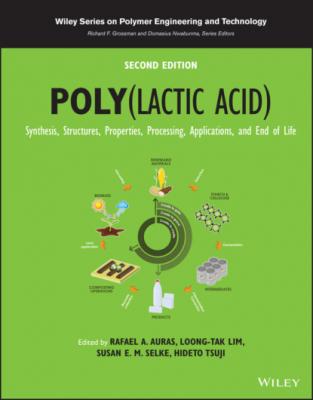Poly(lactic acid). Группа авторов
Читать онлайн.| Название | Poly(lactic acid) |
|---|---|
| Автор произведения | Группа авторов |
| Жанр | Химия |
| Серия | |
| Издательство | Химия |
| Год выпуска | 0 |
| isbn | 9781119767466 |
5.5.3 sc‐PLA–PEG Copolymers
Polyethylene glycol, being hydrophilic in nature, leads to the development of amphiphilic materials when used in combination with hydrophobic polymers [71, 72]. Amphiphilic copolymers based on PLA [73] have received attention in several applications including pharmaceutical, drug delivery [74, 75], hydrogels for tissue engineering [76], and so on. The aqueous self‐assembly of amphiphilic PEG‐sc‐PLA copolymers has been reported by Noack et al. [77] where the block copolymers PEG–PLLA and PEG–PDLA were synthesized by ROP using polyethylene glycol monomethyl ether (PEG–OH) as a macroinitiator for the enantiomeric polymer blending. In these sc‐block copolymers, the decreasing hydrophobic unit (lactide) content led to the increased formation of worm‐like aggregates at ambient conditions. The preferential formation of spherical micelles was observed for the most related block copolymers (as revealed from the dynamic light scattering analysis), which became colloidally unstable upon increasing the crystalline PLA, leading to the formation of worm‐like aggregates [77]. Bio‐functional injectable hydrogels based on PEG‐sc‐PLA were reported by Wang et al. for cartilage tissue engineering [78]. The ROP of D‐ and L‐lactides was performed using four‐arm PEG as a macroinitiator to develop four‐arm PEG‐PDLA and PEG‐PLLA copolymers, respectively. This was followed by synthesizing their cholesterol (Chol)‐modified derivatives, namely four‐arm PEG‐PDLA‐Chol and four‐arm PEG‐PLLA‐Chol, by condensation reaction. The sc blends of the both enantiomers resulted in the stereocomplexes, scPLA (four‐arm‐PEG‐PLA) and scPLA‐Chol (four‐arm PEG‐PLA‐Chol), which were employed as 3D scaffolds for cartilage tissue engineering. The cholesterol‐modified sc‐PLA‐Chol had a higher critical gelation temperature, improved mechanical properties, better adhesion to chondrocytes, and slower degradation than the non‐cholesterol‐modified derivatives, which served as an appropriate material for cartilage regeneration. The thermal and mechanical properties of the sc‐PLA‐based copolymers and composites are reported in Table 5.3.
TABLE 5.3 Thermal and Mechanical Properties Reported for the sc‐PLA‐Based Copolymers and Composites
| Mulchandani et al. [70] | Mulchandani et al. [100] | Noack et al. [77] | Sun et al. [79] | Gupta et al. [80] | Gupta et al. [81] | Gupta et al. [82] | |
|---|---|---|---|---|---|---|---|
| Copolymer/composite | sc‐PLA/PCL | sc‐PLA/PCL | sc‐PLA/PEG | sc‐PLA/GO | sc‐PLA/chitosan | sc‐PLA/CMC | sc‐PLA/n‐HAP |
| T m,hc (°C) | 171–177 | 167–173 | — | 150 | — | 152–180 | 152–178 |
| T m,sc (°C) | 210–235 | 218–222 | 140–200 | 210 | 192–208 | 211 | 210 |
| ΔH m,hc (J/g) | 10–23 | 3.9–27.7 | — | — | — | — | 0–28 |
| ΔH m,sc (J/g) | 30–42 | 22–45.3 | — | — | 20–40 | — | 17–55 |
| Crystallinity sc (%) | — | 1–9 | — | 40–70 | ~70 | 55 | 12–39 |
| Tensile strength (MPa) | 14–30 | 15–33 | — | — | 29–63 | 29–57 | 33–40 |
| Elongation at break (%) | 7–80 | 400–700 | — | — | — | 1.9–36 | 6.3–131 |
| Young’s modulus (GPa) | 0.3–0.7 | 0.3 – 0.9 | — | — | 1.9–2.8 | — | — |
5.6 STEREOCOMPLEX PLA‐BASED COMPOSITES
Stereocomplexation has been used by researchers to impart heat stability to composites. In principle, when the desired properties cannot be achieved by a single component, the incorporation of several fillers may lead to the tailored/desired properties. Stereocomplexed PLA is known for its enhanced thermal resistance, which has been incorporated and modified with fillers such as hydroxyapatite, chitosan, cellulose, graphene, and so on to obtain materials with customized properties. To this end, Total Corbion PLA, a European joint venture company, has already started the development of glass fiber‐reinforced sc‐PLA as an engineering plastic for automotive, aerospace, electronics, home appliance, marine, and construction industries [83]. Sun et al. have grafted graphene oxide (GO) to PDLA by ROP of D‐lactide, where the OH groups on the GO acted as initiator [79]. The grafted PDLA was then blended with PLLA in solution for casting of sc nanocomposite films. The activation energy of crystallization was lowered along with an increased fraction of sc crystallites and improved crystallinity of the nanocomposites, as compared with the PLLA/PDLA blends without the GO filler. This effect may be attributed to the heterogeneous nucleation of GO. The cold crystallization, however, led to lower crystallinity, possibly due to the reduced chain mobility and hindered crystal growth resulting from the exfoliated GO sheets.
Furthermore, Gupta et al. have demonstrated the use of nano‐amphiphilic chitosan to
